
S&P 500
For the very short term, for Friday’s session, a pullback to about 2,828 was expected. A pullback did unfold but was deeper than expected, reaching 2,808.
Summary: Look out for some consolidation next week before the resumption of the upwards trend.
The bigger picture remains extremely bullish. But short term bearish divergence between price and the AD line, along with a Shooting Star candlestick pattern, provide a strong warning here for a pullback or consolidation that may have begun on Friday and may continue next week.
The next target is about 2,915, where another consolidation to last about two weeks may be expected.
The invalidation point remains at 2,743.26.
The mid to longer term target is at 2,922 (Elliott wave) or 3,045 (classic analysis). Another multi week to multi month correction is expected at one of these targets.
The final target for this bull market to end remains at 3,616.
Always practice good risk management. Always trade with stops and invest only 1-5% of equity on any one trade.
The biggest picture, Grand Super Cycle analysis, is here.
Last historic analysis with monthly charts is here, video is here.
ELLIOTT WAVE COUNT
WEEKLY CHART
Cycle wave V must complete as a five structure, which should look clear at the weekly chart level and also now at the monthly chart level. It may only be an impulse or ending diagonal. At this stage, it is clear it is an impulse.
Within cycle wave V, the third waves at all degrees may only subdivide as impulses.
Intermediate wave (4) has breached an Elliott channel drawn using Elliott’s first technique. The channel is redrawn using Elliott’s second technique: the first trend line from the ends of intermediate waves (2) to (4), then a parallel copy on the end of intermediate wave (3). Intermediate wave (5) may end either midway within the channel, or about the upper edge.
Intermediate wave (4) may now be a complete regular contracting triangle lasting fourteen weeks, one longer than a Fibonacci thirteen. There is perfect alternation and excellent proportion between intermediate waves (2) and (4).
Within intermediate wave (5), no second wave correction may move beyond the start of its first wave below 2,594.62. However, the lower edge of the black Elliott channel drawn across the ends of intermediate degree waves should provide very strong support for any deeper pullbacks, holding price well above the invalidation point while intermediate wave (5) unfolds.
At this stage, the expectation is for the final target to me met in October 2019.
A multi week to multi month consolidation for primary wave 4 is expected on the way up to the final target.
The last bullish fifth wave of minor wave 5 to end intermediate wave (3) exhibited commodity like behaviour. It was strong and sustained. It is possible that the upcoming wave of minor wave 5 to end intermediate wave (5) to end primary wave 3 may exhibit similar behaviour, so we should be on the lookout for this possibility.
DAILY CHART
Intermediate wave (5) would be very likely to make at least a slight new high above the end of intermediate wave (3) at 2,872.87 to avoid a truncation.
Intermediate wave (3) exhibits no Fibonacci ratio to intermediate wave (1). It is more likely then that intermediate wave (5) may exhibit a Fibonacci ratio to either of intermediate waves (1) or (3). The most common Fibonacci ratio would be equality in length with intermediate wave (1), but in this instance that would expect a truncation. The next common Fibonacci ratio is used to calculate a target for intermediate wave (5) to end.
It is possible that minute wave iii could be over at this week’s high; if it is complete here, it would not exhibit a Fibonacci ratio to minute wave i. If minute wave iv unfolds next week, then it must be very shallow to remain above minute wave i price territory at 2,791.47.
It is also possible that only minuette wave (iii) within minute wave iii was over at this week’s high, but this idea has less support at the end of this week from classic technical analysis. If minuette wave (iv) continues next week, then it may not move into minuette wave (i) price territory below 2,743.26.
A target is calculated for minor wave 3 to end, which expects to see the most common Fibonacci ratio to minor wave 1. Minor wave 3 may last several weeks in total and should look like an impulse at the daily chart level. When it is complete, then minor wave 4 may last about one to two weeks in order for it to exhibit reasonable proportion to minor wave 2. Minor wave 4 must remain above minor wave 1 price territory.
A best fit channel is added in taupe to this chart. It contains all of intermediate wave (5) so far. The lower edge may provide support for any deeper pullbacks. The upper edge may provide resistance.
TECHNICAL ANALYSIS
WEEKLY CHART
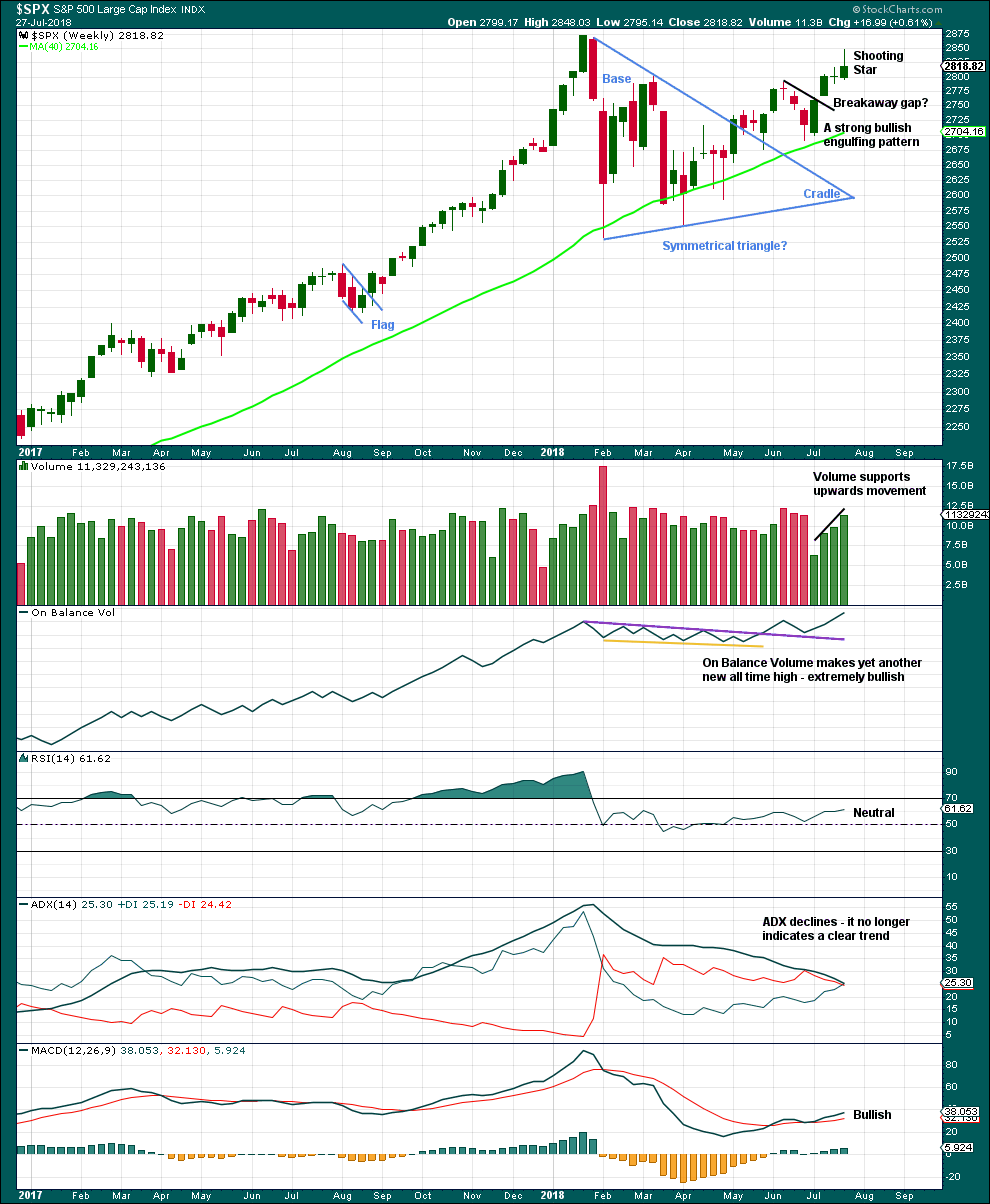
Click chart to enlarge. Chart courtesy of StockCharts.com.
Recent new highs for On Balance Volume remains very bullish indeed, but that does not preclude another reasonable pullback within this developing upwards trend. It is still expected that price is very likely to make new all time highs, but it will not move in a straight line.
A Doji candlestick followed now by a Shooting Star, which did not gap higher, is reasonably bearish for the short term. A pullback or small consolidation may result.
Bullish volume and another new all time high from On Balance Volume are very strong bullish signals.
DAILY CHART
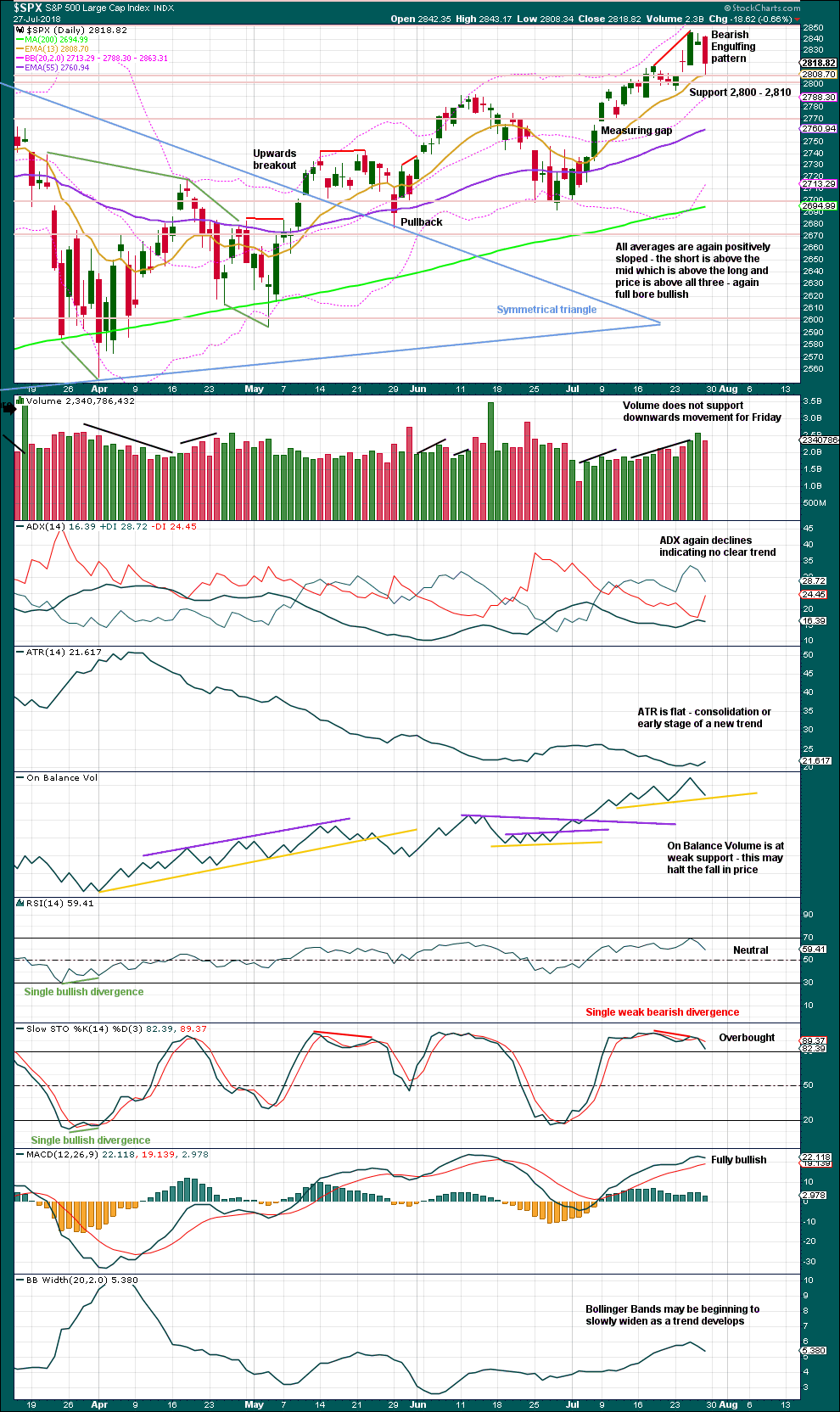
Click chart to enlarge. Chart courtesy of StockCharts.com.
The symmetrical triangle may now be complete. The base distance is 340.18. Added to the breakout point of 2,704.54 this gives a target at 3,044.72. This is above the Elliott wave target at 2,922, so the Elliott wave target may be inadequate.
Since the low on the 2nd of April, 2018, price has made a series of higher highs and higher lows. This is the definition of an upwards trend. But trends do not move in perfectly straight lines; there are pullbacks and bounces along the way.
Stochastics may remain overbought for reasonable periods of time when this market has a strong bull run.
This bull run now has some support from volume and strong support from On Balance Volume making new all time highs.
RSI is almost overbought, and it can remain there for long periods of time for this market.
For the very short term, Thursday’s candlestick may be a Gravestone Doji, which is a bearish reversal pattern. This is now followed by a Bearish Engulfing reversal pattern for Friday. These together are a strong warning that a consolidation or pullback may develop here.
Look for the first strong support at about 2,800 to 2,810. Next strong support below that is about 2,765.
VOLATILITY – INVERTED VIX CHART
WEEKLY CHART
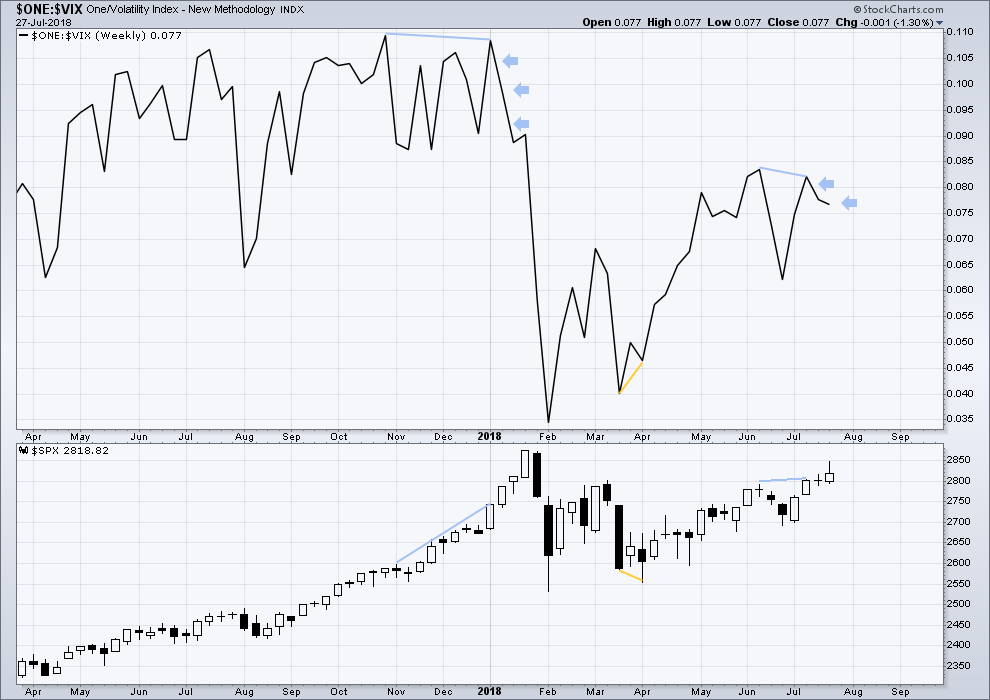
Click chart to enlarge. Chart courtesy of StockCharts.com. So that colour blind members are included, bearish signals
will be noted with blue and bullish signals with yellow.
To keep an eye on the all time high for inverted VIX a weekly chart is required at this time.
Notice how inverted VIX has very strong bearish signals four weeks in a row just before the start of the last large fall in price. At the weekly chart level, this indicator may be useful again in warning of the end of primary wave 3.
There is bearish divergence at this time between swing highs of inverted VIX and price, and now two weeks in a row of upwards movement from price and downwards movement from inverted VIX. This is now a reasonable warning of a possible pullback or consolidation, but it is not as strong a warning as that back in January. The last two weeks of upwards movement in price is not particularly strong (completing a Doji and a Shooting Star, not strong upwards candlesticks), so this divergence is not as significant.
DAILY CHART

Click chart to enlarge. Chart courtesy of StockCharts.com. So that colour blind members are included, bearish signals
will be noted with blue and bullish signals with yellow.
Normally, volatility should decline as price moves higher and increase as price moves lower. This means that normally inverted VIX should move in the same direction as price.
There is new short term bearish divergence today between price and inverted VIX: inverted VIX has made a new low below its prior swing low six sessions ago, but price has not made a corresponding new low.
There is now a cluster of bearish signals from inverted VIX.
BREADTH – AD LINE
WEEKLY CHART
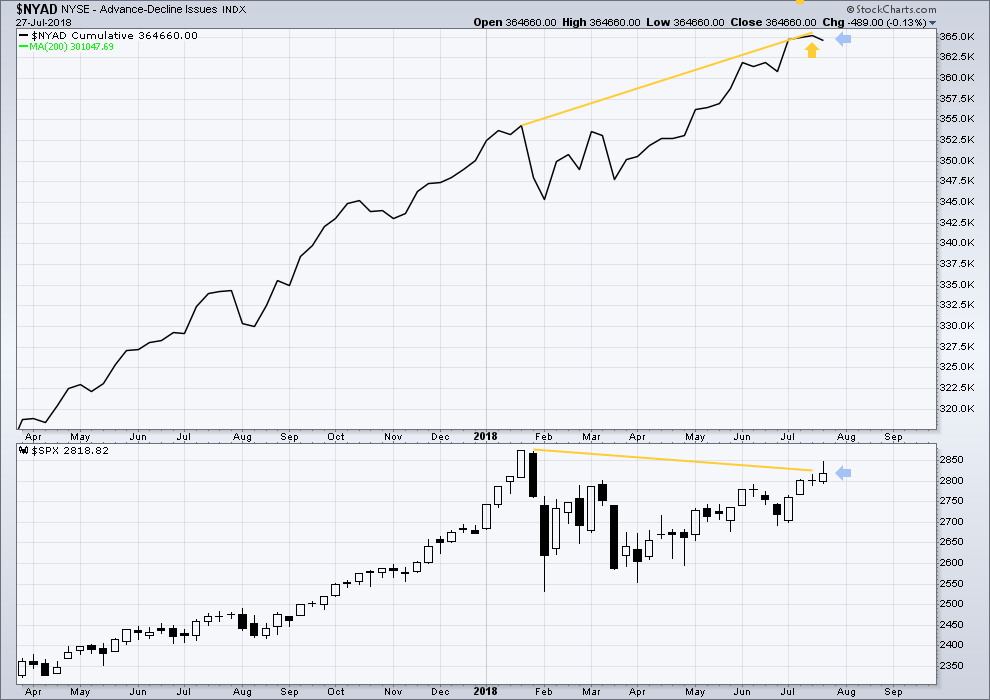
Click chart to enlarge. Chart courtesy of StockCharts.com.
When primary wave 3 comes to an end, it may be valuable to watch the AD line at the weekly time frame as well as the daily.
At this stage, there is very strong bullish divergence between price and the AD line at the weekly time frame. With the AD line making new all time highs, expect price to follow through with new all time highs in coming weeks.
Price moved higher this week, but the AD line moved lower. This single week divergence is bearish for the short term.
DAILY CHART
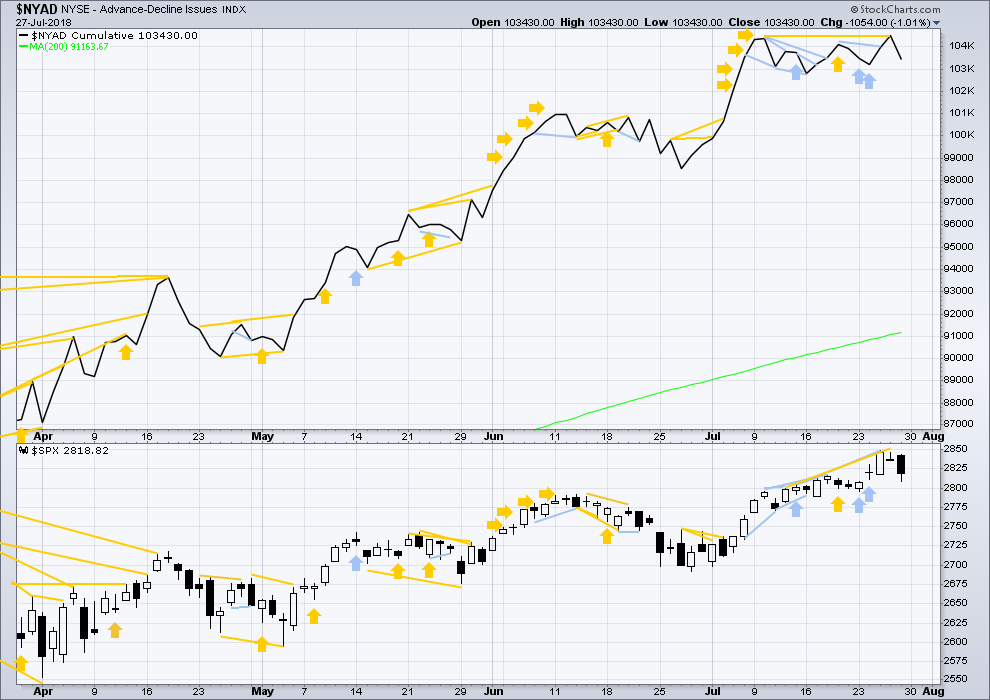
Click chart to enlarge. Chart courtesy of StockCharts.com.
There is normally 4-6 months divergence between price and market breadth prior to a full fledged bear market. This has been so for all major bear markets within the last 90 odd years. With no longer term divergence yet at this point, any decline in price should be expected to be a pullback within an ongoing bull market and not necessarily the start of a bear market. New all time highs from the AD line means that any bear market may now be an absolute minimum of 4 months away. It may of course be a lot longer than that. My next expectation for the end of this bull market may now be October 2019.
Breadth should be read as a leading indicator.
A new all time high from the AD line on Thursday remains very bullish. For the short term, there is no bearish divergence between price and the AD line at the daily chart time frame.
Small caps have made another slight new all time on Friday. Mid caps made a new all time high on the 10th of July. Only large caps have to follow through; they do usually lag in the latter stages of a bull market.
DOW THEORY
The following lows need to be exceeded for Dow Theory to confirm the end of the bull market and a change to a bear market:
DJIA: 23,360.29.
DJT: 9,806.79.
S&P500: 2,532.69.
Nasdaq: 6,630.67.
Only Nasdaq at this stage is making new all time highs, with another new all time high on Friday of last week. DJIA and DJT need to make new all time highs for the ongoing bull market to be confirmed.
GOLD
The alternate daily Elliott wave count remains valid.
Summary: A new high now above 1,234.76 would add reasonable confidence that a low is in place, but prior to that it will remain possible that a new low may occur before a trend change.
At the end of this week, On Balance Volume makes new lows at the weekly and daily chart levels. This is very bearish and supports the alternate daily Elliott wave count. If the target at 1,211 is wrong, it may not be low enough. A classic analysis target is about 1,160.
Always trade with stops to protect your account. Risk only 1-5% of equity on any one trade.
Grand SuperCycle analysis is here.
Last historic analysis with monthly charts and several weekly alternates is here, video is here.
Last remaining four weekly wave counts were updated here, and video here.
MAIN ELLIOTT WAVE COUNT
WEEKLY CHART – TRIANGLE
There are four remaining weekly wave counts at this time for cycle wave b: a triangle, flat, combination or double zigzag. At this stage, all four expect a bounce over the next few weeks, and the triangle has the best look.
While the direction does not diverge for these four weekly wave counts, only one weekly wave count shall be published on a daily basis, so that the analysis is manageable for me to publish and for members to digest. Note: This does not mean that the remaining three counts may not be correct.
The triangle so far has the best fit and look.
Cycle wave b may be an incomplete triangle. The triangle may be a contracting or barrier triangle, with a contracting triangle looking much more likely because the A-C trend line does not have a strong slope. A contracting triangle could see the B-D trend line have a stronger slope, so that the triangle trend lines converge at a reasonable rate. A barrier triangle would have a B-D trend line that would be essentially flat, and the triangle trend lines would barely converge.
Within a contracting triangle, primary wave D may not move beyond the end of primary wave B below 1,123.08. Within a barrier triangle, primary wave D may end about the same level as primary wave B at 1,123.08, so that the B-D trend line is essentially flat. Only a new low reasonably below 1,123.08 would invalidate the triangle.
Within both a contracting and barrier triangle, primary wave E may not move beyond the end of primary wave C above 1,365.68.
Four of the five sub-waves of a triangle must be zigzags, with only one sub-wave allowed to be a multiple zigzag. Primary wave C is the most common sub-wave to subdivide as a multiple, and this is how primary wave C for this example fits best.
Primary wave D must be a single structure, most likely a zigzag. It is possible that primary wave D could be over.
One triangle sub-wave tends to be close to 0.618 the length of its predecessor; if primary wave D is over at last week’s low, it is just 3.64 below this point.
There are no problems in terms of subdivisions or rare structures for this wave count. It has an excellent fit and so far a typical look.
DAILY CHART – TRIANGLE
It is possible that primary wave D is over. The structure may be seen complete.
At this stage, the best target calculation for primary wave E would be 0.618 the length of primary wave D. This yields a target that is within a very strong area of resistance.
When intermediate waves (A) and (B) within primary wave E may be complete, then the ratio between intermediate waves (A) and (C) may be used to add to the target calculation at a second degree. At that stage, it may change or widen to a zone.
Primary wave E would be most likely to fall reasonably short of the A-C trend line.
In the first instance, primary wave E may be expected to last about a Fibonacci 21 weeks. It is also possible that it may not last that long because E waves of a triangle can be relatively quick.
DAILY CHART – TRIANGLE – ALTERNATE
It is possible that primary wave D is not over and one final new low may complete it.
Within the impulse of intermediate wave (C), minor wave 3 is shorter than minor wave 1. Therefore, minor wave 5 is limited to no longer than equality in length with minor wave 3, so that the core rule stating a third wave may not be the shortest wave would be met.
Minor wave 5 may be incomplete, and within it minute wave iv may now be a complete zigzag.
If the target at 1,211 is wrong, then it may not be low enough. At the end of this week, On Balance Volume has made new lows at both the daily and weekly time frames, which when combined is a very bearish signal.
TECHNICAL ANALYSIS
WEEKLY CHART
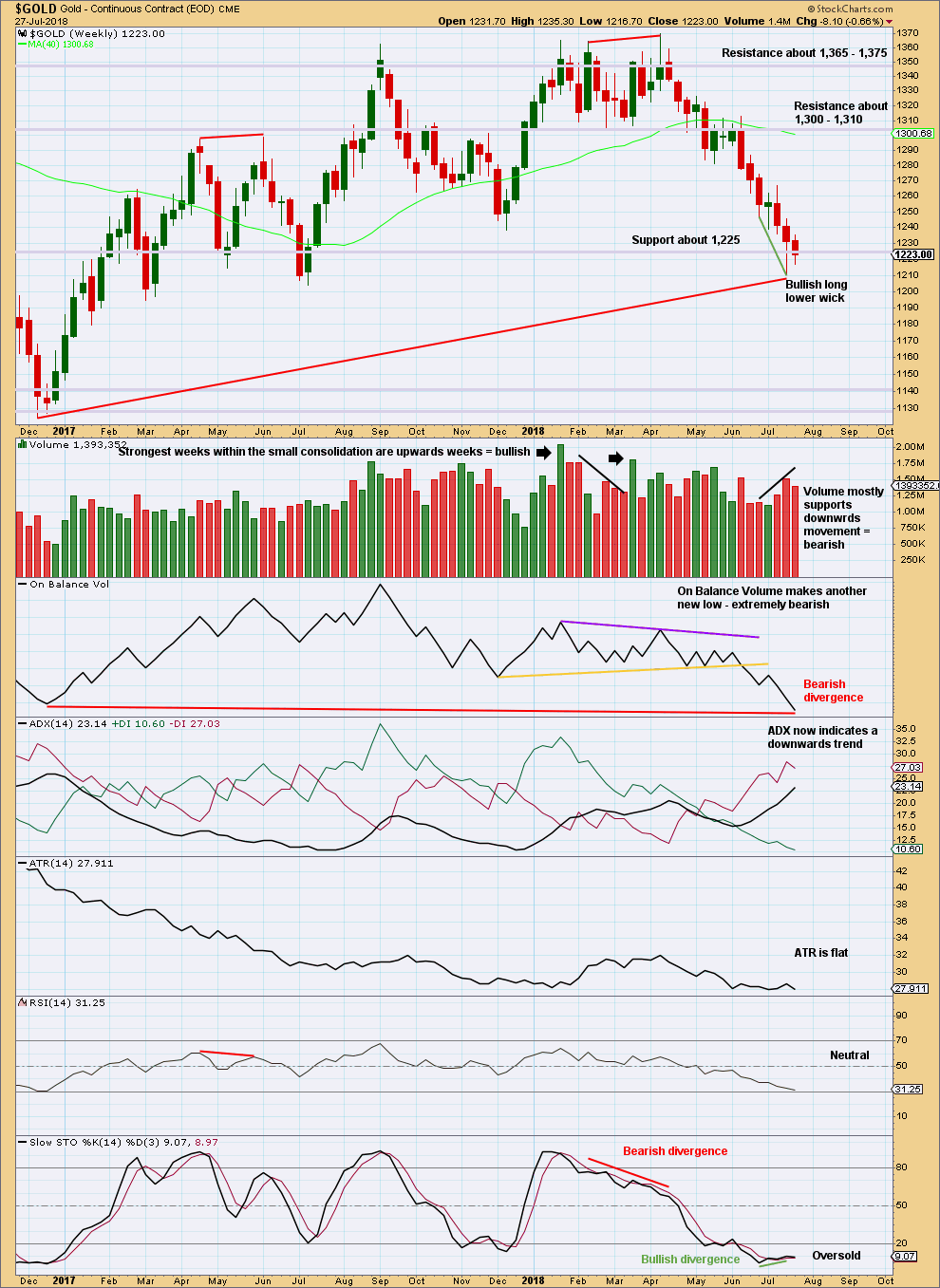
Click chart to enlarge. Chart courtesy of StockCharts.com.
On Balance Volume this week makes another new low. This new low is below the prior low of the week beginning 12th of December, 2016. This divergence is bearish.
Slightly lighter volume for this last inside week is very slightly bullish for the short term.
DAILY CHART
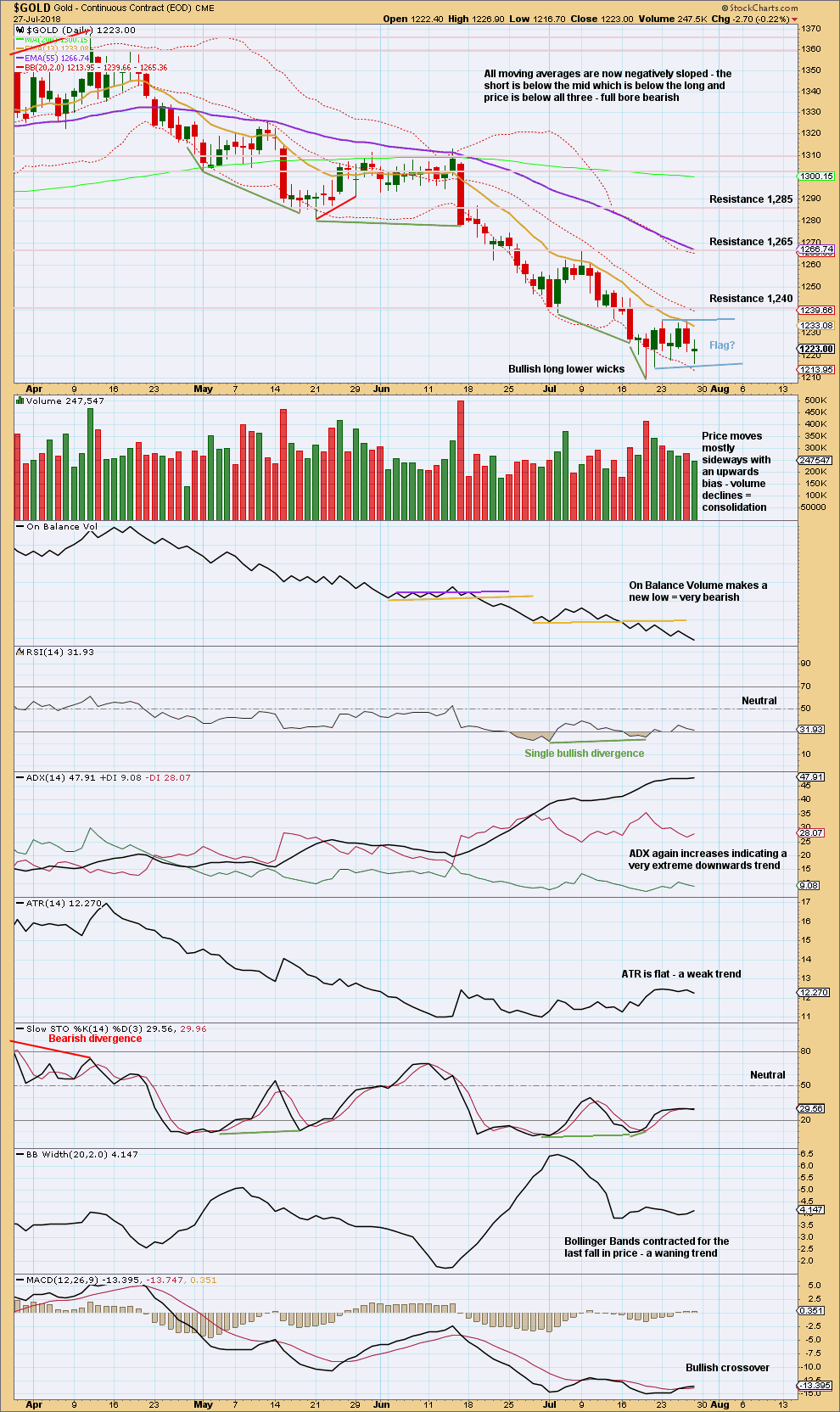
Click chart to enlarge. Chart courtesy of StockCharts.com.
The pennant pattern is no longer valid. But a flag pattern may now be forming, which are also reliable continuation patterns. Volume during the pattern though is strongest for an upwards day, contradicting the continuation implications of the pattern.
Volume does normally decline during the formation of flag patterns. The best flags are no longer than 15 days in duration. So far this one has lasted six days. A target using the measured rule would be about 1,160.
The new low from On Balance Volume is extremely bearish.
However, ADX is very extreme indeed. While it can reach very extreme for this market, it is at this time nearing as extreme as it was in early August 2015. At that point, price was in an extreme downwards trend that was relieved by a bounce of $106.42 lasting 58 days.
If a low is not yet in place, then it may be reasonably soon.
GDX WEEKLY CHART

Click chart to enlarge. Chart courtesy of StockCharts.com.
GDX has been range bounce since January 2017. This is a very long sideways consolidation. The longer it continues, the more sustained the eventual breakout will be. Volume suggests the breakout may more likely be downwards.
Support about 20.80 has been tested about eight times and so far has held. The more often a support area is tested and holds, the more technical significance it has.
With a very bearish signal now from On Balance Volume and support from volume for falling price, look out not only for a test (again) of support about 20.80 but also for a possible break below this point. A close below 20.80 would be extremely bearish. Expect then to see GDX likely to continue in a strong downwards trend to new lows that may last over a year.
GDX DAILY CHART
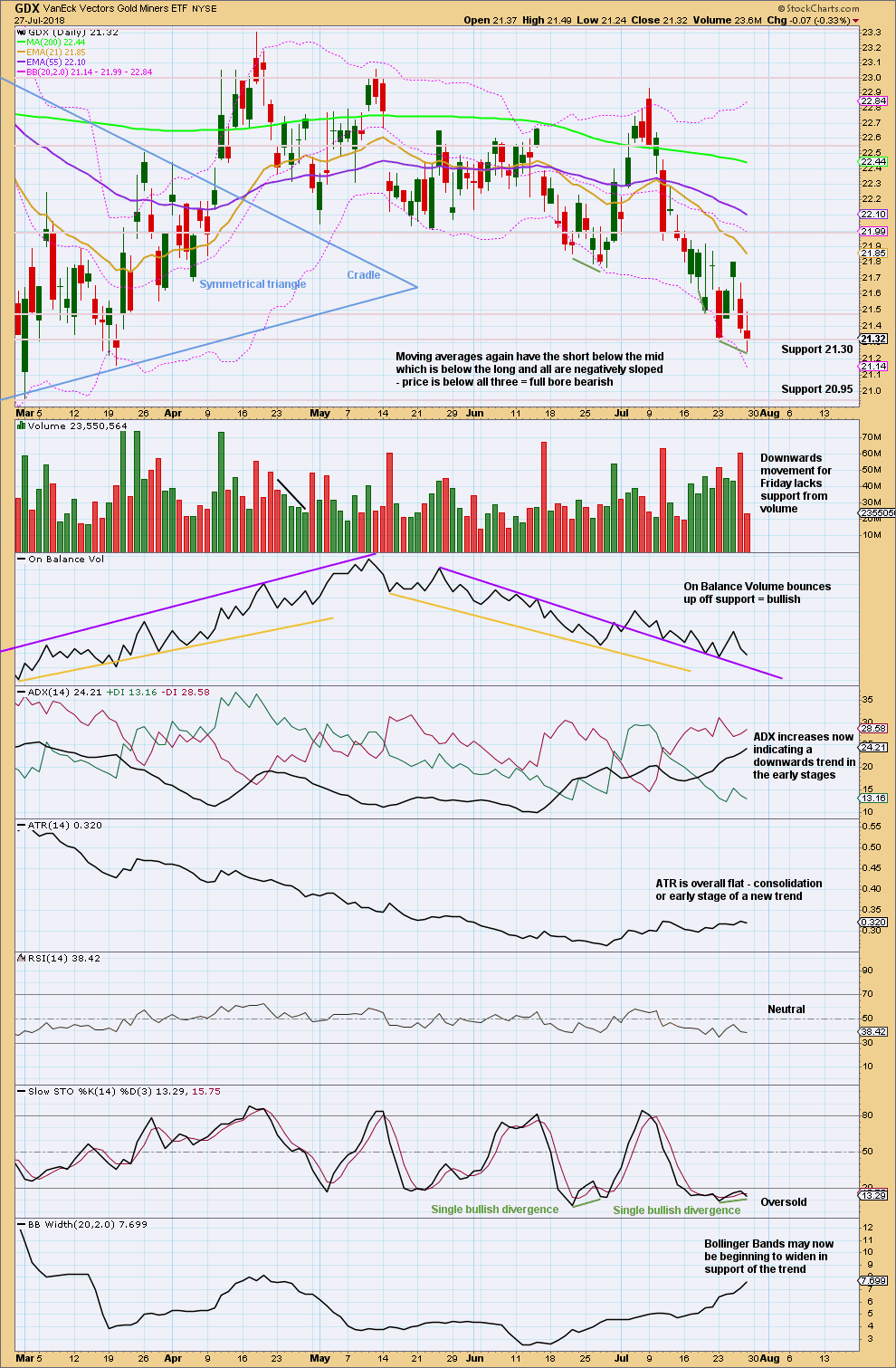
Click chart to enlarge. Chart courtesy of StockCharts.com.
Friday’s session was unable to close below support at 21.30. The market fell of its own weight on Friday. This is not necessarily bullish though, and this can persist for a reasonable period of time.
GDX is now in a downwards trend. There will be bounces and consolidations along the way down. Single bullish divergence with weakness in Friday’s downwards movement suggests a bounce may come early next week.
US OIL
For the short term, a little upwards movement was expected for the week. An inside week closes green with a very small range, mostly fitting expectations.
Summary: This downwards swing may now continue to about 61.22. For the very short term, look out for a bounce to end about 72.12.
A deeper and longer lasting consolidation may be underway, which may last about 13 to 21 weeks in total. It should remain above 55.24, and the target is about 61.12. The consolidation will not move in a straight line; it may swing from resistance to support and back again in large swings. Once resistance and support are identified, then a swing trading system may be employed by more experienced traders. Support may now be about 63.0 and resistance may be about 75.25.
Always practice good risk management as the most important aspect of trading. Always trade with stops and invest only 1-5% of equity on any one trade. Failure to manage risk is the most common mistake new traders make.
MAIN WAVE COUNT
MONTHLY CHART
The bear market for US Oil looks to be over and a new bull market looks to be in its very early stages. The prior bearish wave count has been invalidated, leaving only this very bullish wave count.
A huge zigzag down to the last low may be complete and is labelled here Super Cycle wave (II).
Cycle wave b must be seen as complete in August 2013 for this wave count to work. It cannot be seen as complete at the prior major swing high in May 2011.
Cycle wave b is seen as a zigzag, and within it primary wave B is seen as a running contracting triangle. These are fairly common structures, although nine wave triangles are uncommon. All subdivisions fit.
Primary wave C moves beyond the end of primary wave A, so it avoids a truncation. But it does not have to move above the price territory of primary wave B to avoid a truncation, which is an important distinction.
If cycle wave b begins there, then cycle wave c may be seen as a complete five wave impulse.
Super Cycle wave (III) must move beyond the end of Super Cycle wave (I). It must move far enough above that point to allow room for a subsequent Super Cycle wave (IV) to unfold and remain above Super Cycle wave (I) price territory.
Cycle wave I may be incomplete. It may be unfolding as an impulse and may have now moved through the middle portion. Commodities have a tendency to exhibit swift strong fifth waves, and this tendency is especially prevalent for third wave impulses. Intermediate wave (5) to end primary wave 3 may be very swift and strong, ending with a blow off top.
When cycle wave I is complete, then cycle wave II may be a deep correction that may not move beyond the start of cycle wave I below 26.06.
Data from FXCM for USOil does not go back to the beginning of Super Cycle wave (I). Without an accurate known length of Super Cycle wave (I) a target cannot be calculated for Super Cycle wave (III) to end using Fibonacci ratios. The target for Super Cycle wave (III) may be calculated when cycle waves I, II, III and IV within it are complete. That cannot be done for many years.
WEEKLY CHART
Intermediate wave (3) may now be complete. There is no Fibonacci ratio between intermediate waves (1) and (3), and intermediate wave (3) is longer than 1.618 the length of intermediate wave (1).
This wave count fits with classic technical analysis at the monthly and daily chart levels.
Intermediate wave (2) was a deep double zigzag. Given the guideline of alternation, intermediate wave (4) may be expected to most likely be a shallow flat, triangle or combination. It may be about even in duration with intermediate wave (2), or it may be a little longer because triangles and combinations are more time consuming structures.
In the first instance, a Fibonacci 13 weeks may be expected for intermediate wave (4). If about that time the structure is incomplete, then the next Fibonacci number in the sequence at 21 will be expected. At this stage, it has lasted only 9 weeks.
Intermediate wave (4) may find support about the lower edge of the black Elliott channel. It may end within the price territory of the fourth wave of one lesser degree; minor wave 4 has its territory from 66.65 to 59.13.
At this stage, there are still multiple structural options for intermediate wave (4) to complete as. They will be separated out into separate charts.
FLAT
Of all the daily charts, this first chart at this stage has the best look and may have the highest probability.
Intermediate wave (4) may be unfolding as a flat correction. Within the flat correction, minor wave A may be a complete zigzag and minor wave B may be a complete expanded flat correction, a 1.27 length of minor wave A, which is within the most common range of from 1 to 1.38. An expanded flat is indicated.
Expanded flats normally see C waves move substantially beyond the end of their A waves. A target for minor wave C is calculated, which expects it to exhibit a common Fibonacci ratio to minor wave A. This target is very close to the 0.382 Fibonacci ratio of intermediate wave (3).
Minor wave C must subdivide as a five wave structure, and within it minute wave ii may not move beyond the start of minute wave i above 75.26.
Intermediate wave (4) may not move into intermediate wave (1) price territory below 55.24.
FLAT – ALTERNATE
This alternate idea is identical to the first flat wave count with the exception of the degree of labelling. Here, the degree of labelling within intermediate wave (4) is moved down one degree. Minor wave A may be an incomplete flat correction.
The target and expected direction is the same. The upper invalidation point is the same for the short to mid term.
This wave count allows for intermediate wave (4) to be longer lasting.
COMBINATION
Intermediate wave (4) may be unfolding as a double combination.
The first structure in the double may be a completed zigzag labelled minor wave W. The double may be joined by a three in the opposite direction, an expanded flat labelled minor wave X.
The second structure in the double may be either a flat or a triangle, with a flat correction much more likely, so that is what will be expected.
Within the flat correction of minor wave Y, minute wave a must subdivide as a three. Minute wave a may be subdividing as a zigzag, and within it minuette wave (b) may not move beyond the start of minuette wave (a) above 75.26.
Within the flat correction of minor wave Y, when minute wave a is a completed three wave structure, then minute wave b must unfold upwards and must retrace a minimum 0.9 length of minute wave a. Minute wave b at that stage may make a new high above the start of minute wave a at 75.26.
Minor wave Y would most likely end about the same level as minor wave W at 64.22, so that the whole structure takes up time and moves price sideways.
COMBINATION – ALTERNATE
This alternate idea for the combination again moves the degree of labelling within intermediate wave (4) all down one degree.
The first structure in a double combination may be an incomplete flat correction labelled minor wave W.
When minor wave W is complete, then minor wave X should unfold as a three wave structure upwards, most likely a zigzag. Minor wave X has no minimum requirement nor no maximum allowable length.
Thereafter, minor wave Y would most likely be a zigzag and would most likely end about the same level as minor wave W, so that the whole structure takes up time and moves price sideways.
A double combination with this degree of labelling could take several more weeks to unfold.
TRIANGLE
Intermediate wave (4) may be unfolding as a triangle.
Within the triangle, minor wave A should be seen as over at the last low. This is problematic because it does not fit as a single zigzag. It can be seen complete as a double zigzag, but this looks forced because minute wave w does not look like a very clear three.
If minor wave A is a double zigzag, then all remaining triangle sub-waves must subdivide as single structures. All but one of them must be zigzags and one triangle sub-wave may be another type of corrective structure.
Within the triangle, minor wave C may be unfolding as a zigzag; within it, minute wave b may not move beyond the start of minute wave a above 75.26.
Minor wave C may not move beyond the end of minor wave A below 63.60.
A triangle may take several more weeks to complete. They are often very time consuming structures.
TECHNICAL ANALYSIS
MONTHLY CHART
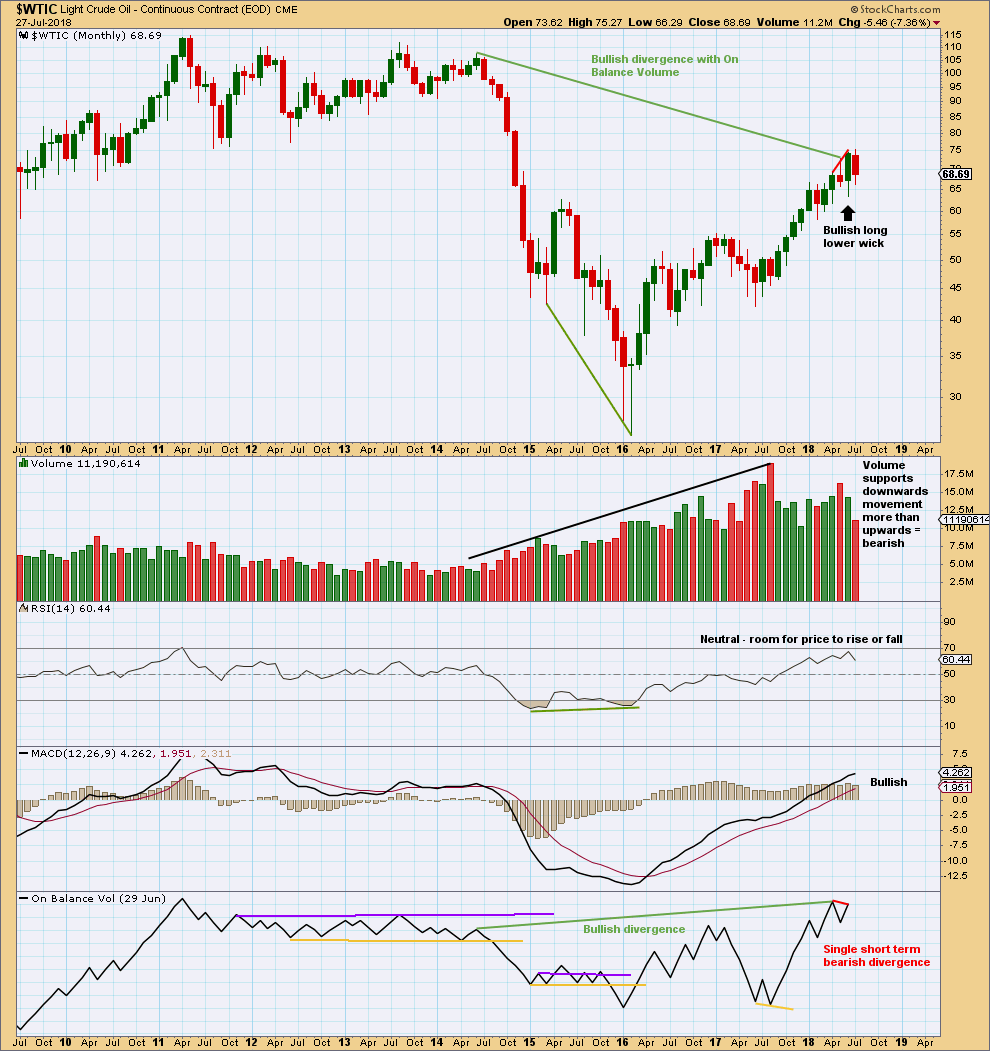
Click chart to enlarge. Chart courtesy of StockCharts.com.
The short term volume profile is bearish: the strongest month in the last few months was the downwards month of May (where the balance of volume was down) and now June shows a decline in volume, so volume has not supported upwards movement here.
For the short term, On Balance Volume is also slightly bearish. This supports the idea that price may be within a correction and not necessarily a continuation of the larger upwards trend.
However, it is entirely possible that this situation could reverse and volume could start to support upwards movement, as has happened back in January 2018.
The larger trend is upwards.
DAILY CHART

Click chart to enlarge. Chart courtesy of StockCharts.com.
ADX now indicates no clear trend; the market may be consolidating.
Expect swings from support to resistance and back again, using Stochastics to indicate when each swing may end.
The bounce within the downwards swing lacks support from volume. This supports the idea that for now the downwards swing is likely to continue.
Look for next support at 64.50 to 64.10, and below that about 62.00.
This bounce has brought Stochastics up from oversold. There is again room for the downwards swing to continue. There is also still room for the bounce to move higher.

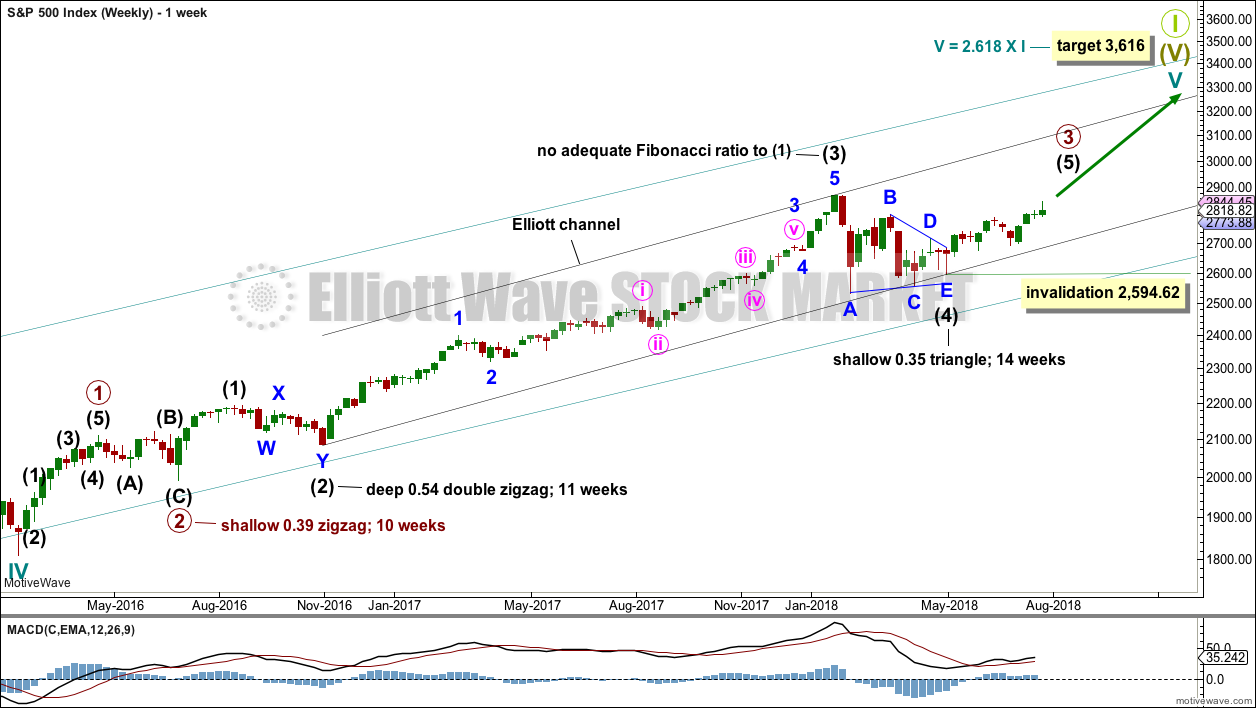
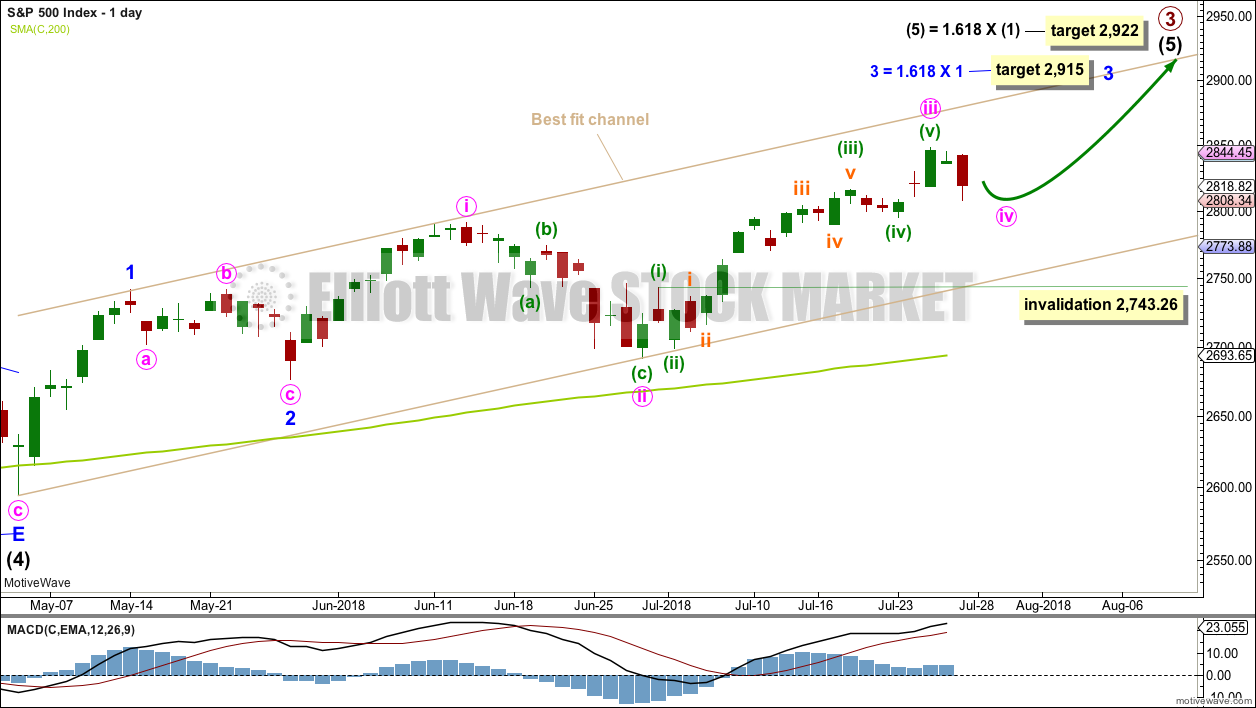

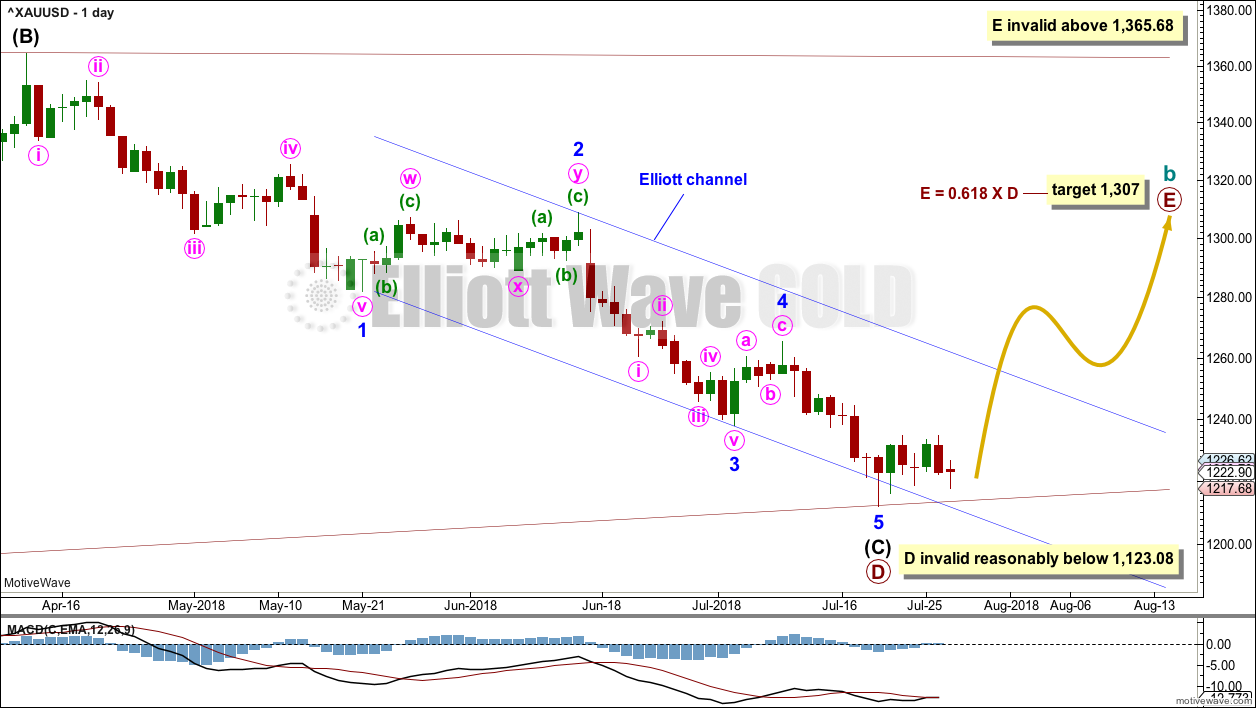

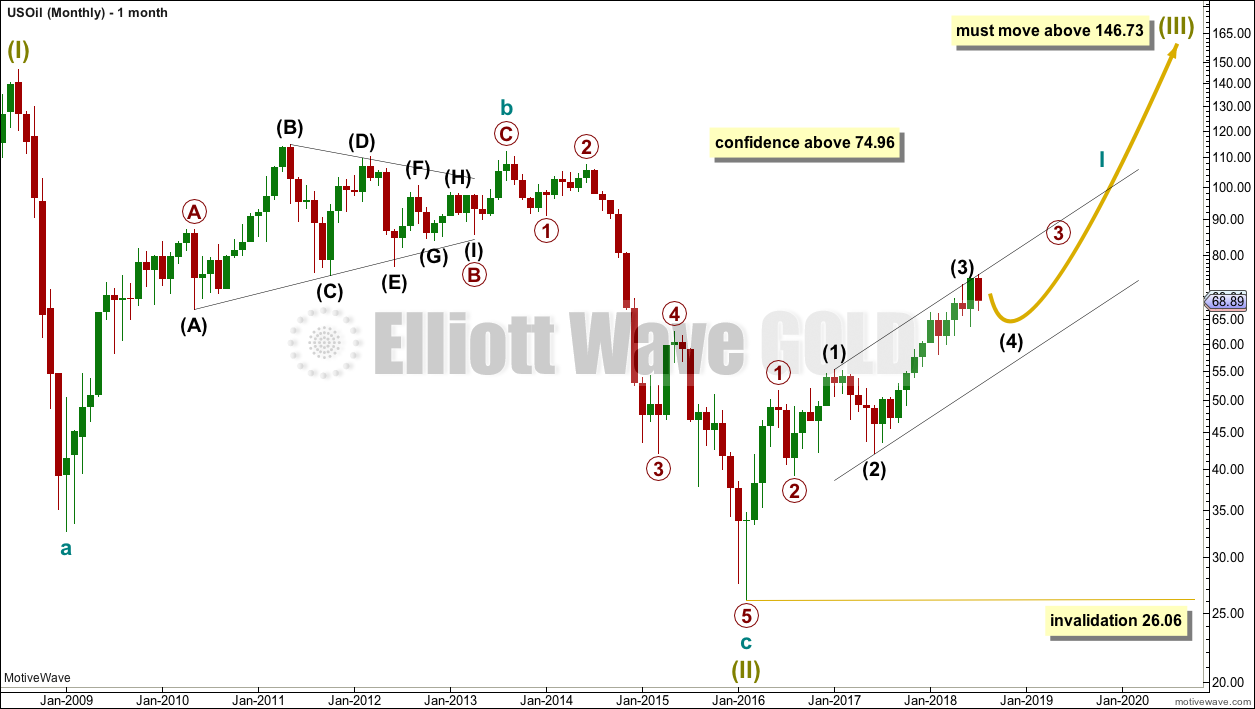
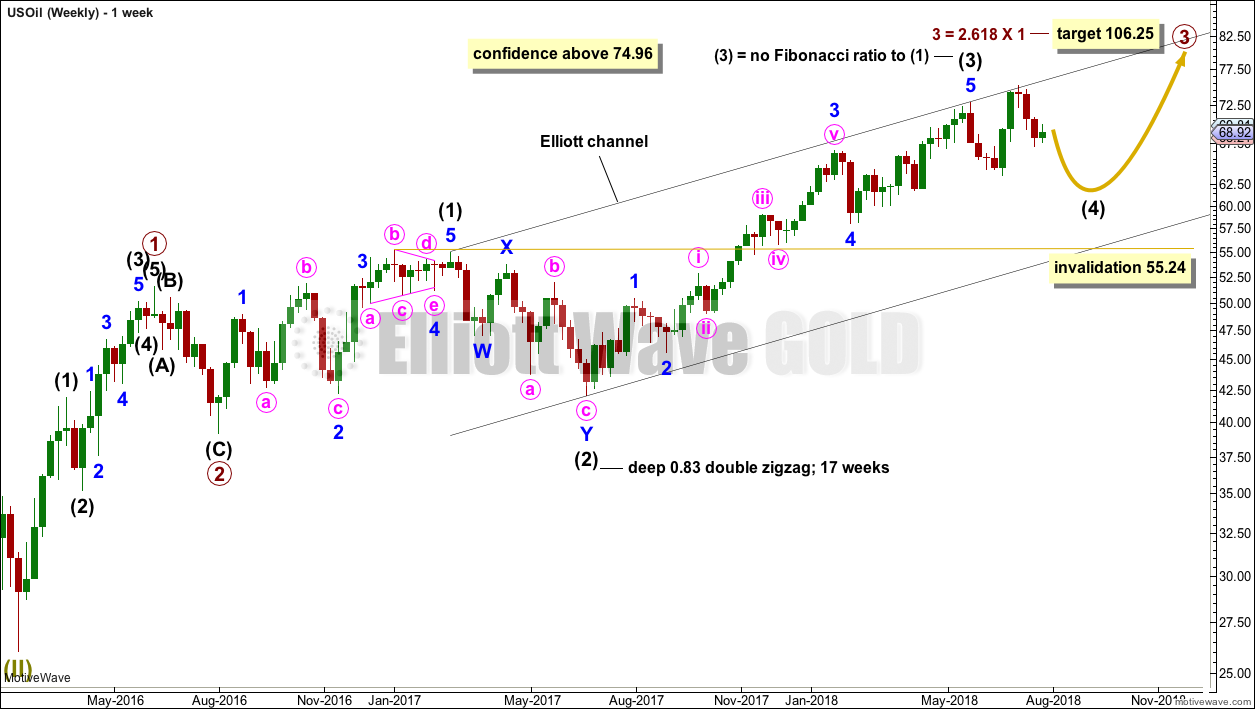
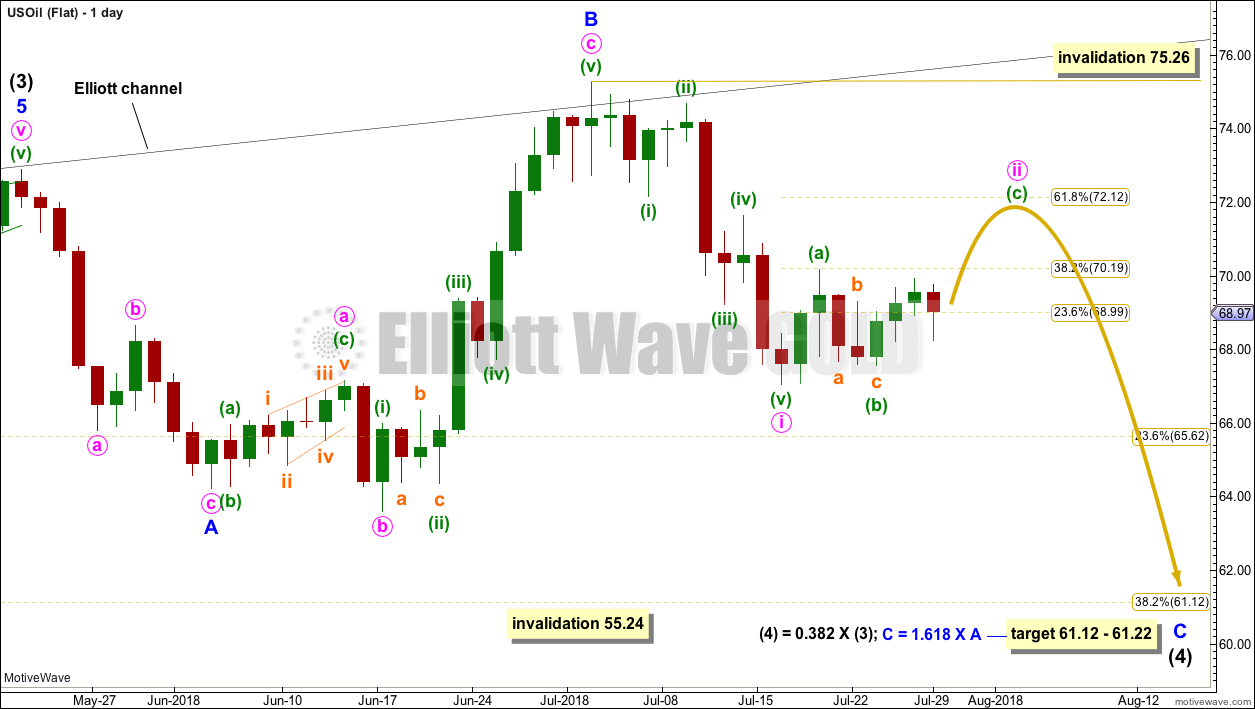
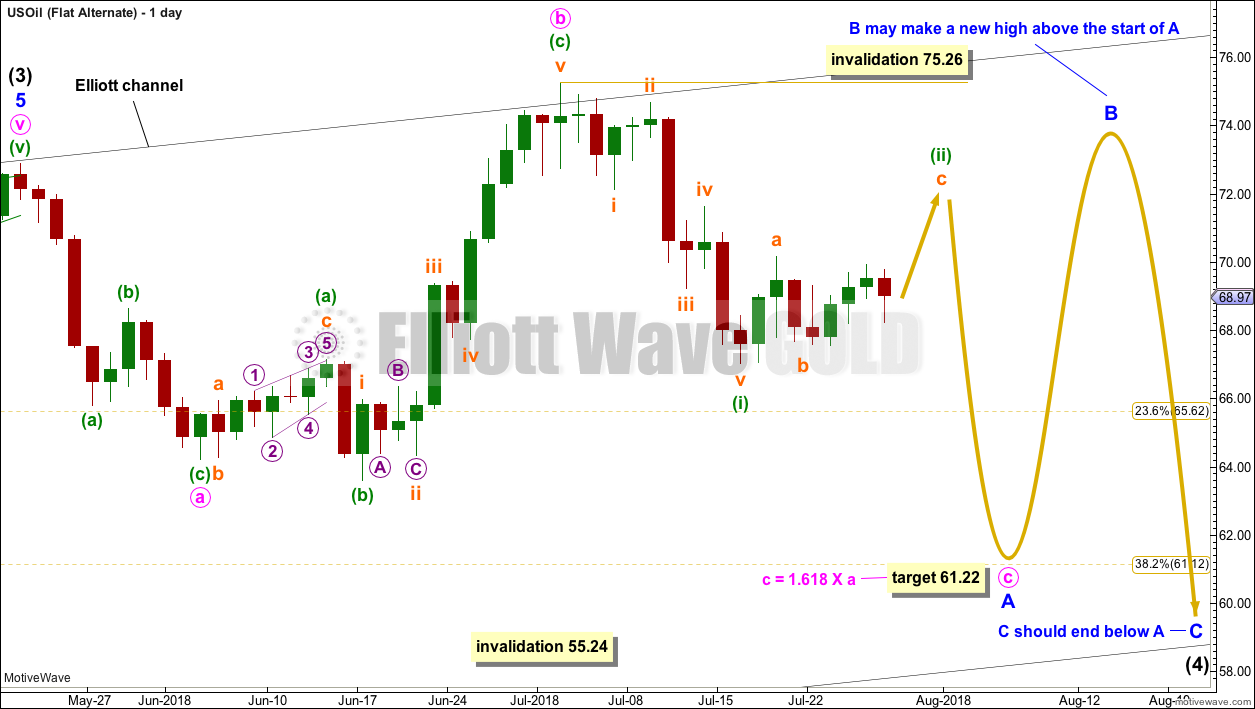
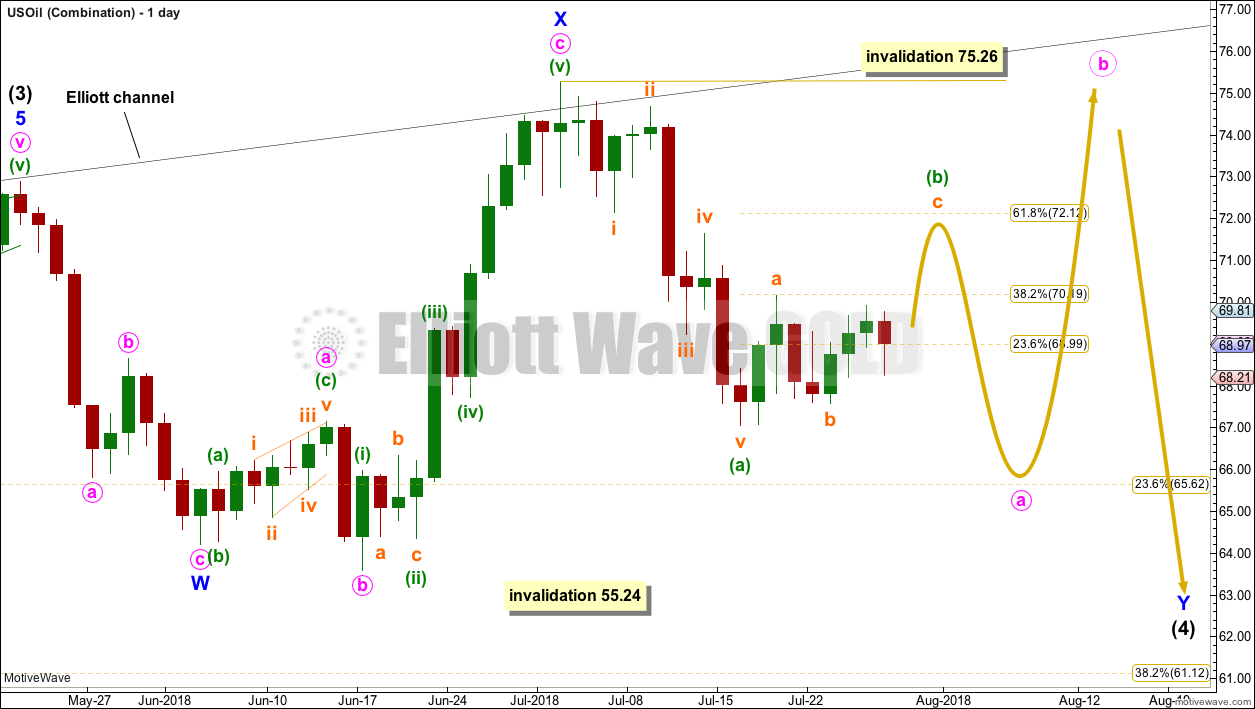

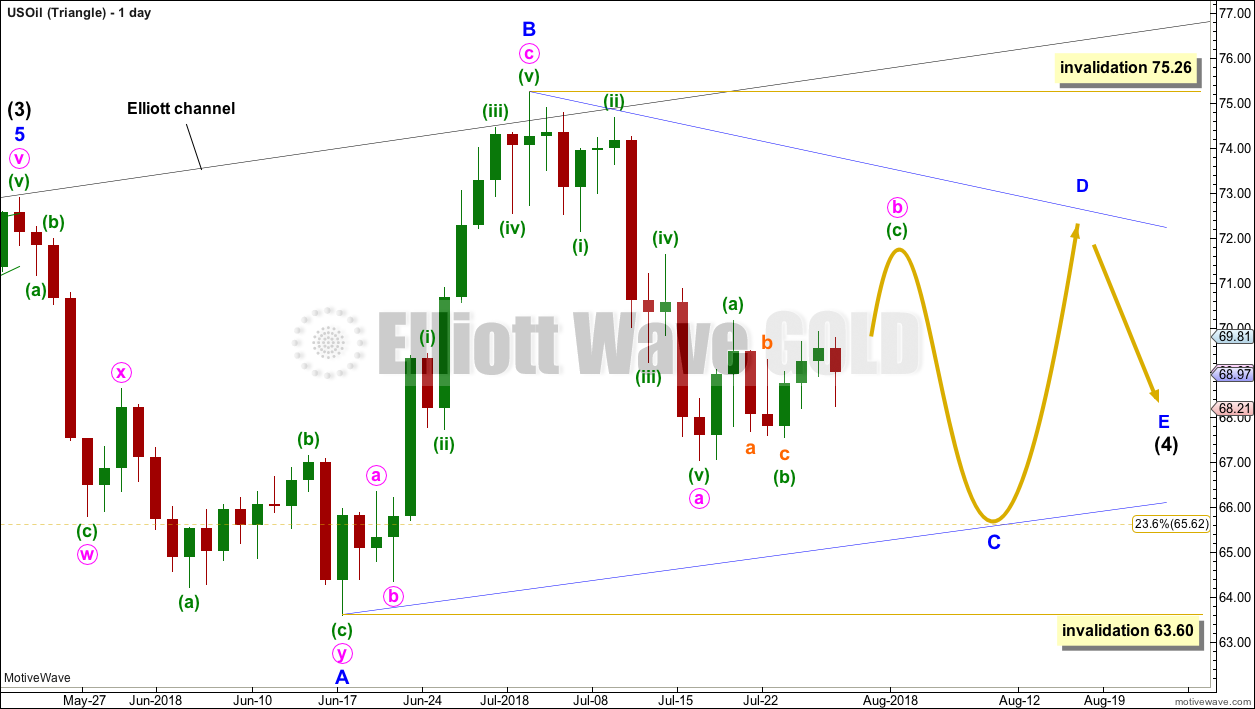
For the S&P today:
While price remains above 2,791.47 expect that a shallow consolidation is most likely unfolding, to continue a little lower tomorrow and maybe thereafter to continue sideways for a few days.
A new low below 2,791.47 would indicate a deeper pullback may continue, the target for it to end would then be about 2,752. Look for support at the lower edge of the taupe best fit channel if another deeper pullback does eventuate here.
Lara
As always thanks for the weekly update.
As we get closer to some end points, could you clarify on the S&P Elliott Wave Analysis. You’ve stated the next target is expected to be 2915. I assume that would be the end of minor wave 3. At that point minor wave 4 could pull us back to 2740 price territory without violating the price territory of minor wave 1. Then minor wave 5 to a target of 2922 which is not much above the target of minor wave 3. This would also be the target of primary wave 3. And as you have projected the beginning of a deeper pullback perhaps a multi week or multi month correction for primary 4.
Is this pretty much capture the way yo are interpreting the next few wave targets?
Thanks as always for your feedback
Rich
Yes, thats exactly how the wave count expects it to unfold.
It could of course change, and if it does that will be outlined in my analysis.
As each wave comes closer to its end I may be able to add to target calculations at lower degrees, and can then also use channels to indicate when one wave is complete and the next has begun.